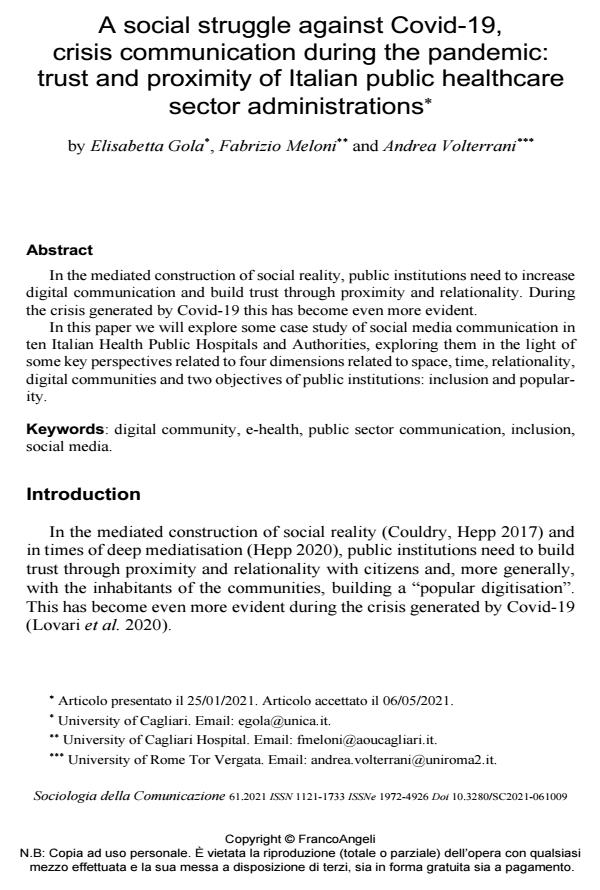A social struggle against Covid-19, crisis communication during the pandemic: trust and proximity of Italian public healthcare sector administrations
Titolo Rivista SOCIOLOGIA DELLA COMUNICAZIONE
Autori/Curatori Elisabetta Gola, Fabrizio Meloni, Andrea Volterrani
Anno di pubblicazione 2021 Fascicolo 2021/61 Lingua Inglese
Numero pagine 19 P. 127-145 Dimensione file 615 KB
DOI 10.3280/SC2021-061009
Il DOI è il codice a barre della proprietà intellettuale: per saperne di più
clicca qui
Qui sotto puoi vedere in anteprima la prima pagina di questo articolo.
Se questo articolo ti interessa, lo puoi acquistare (e scaricare in formato pdf) seguendo le facili indicazioni per acquistare il download credit. Acquista Download Credits per scaricare questo Articolo in formato PDF

FrancoAngeli è membro della Publishers International Linking Association, Inc (PILA)associazione indipendente e non profit per facilitare (attraverso i servizi tecnologici implementati da CrossRef.org) l’accesso degli studiosi ai contenuti digitali nelle pubblicazioni professionali e scientifiche
In the mediated construction of social reality, public institutions need to in-crease digital communication and build trust through proximity and relationality. During the crisis generated by Covid-19 this has become even more evident. In this paper we will explore some case study of social media communication in ten Italian Health Public Hospitals and Authorities, exploring them in the light of some key perspectives related to four dimensions related to space, time, relational-ity, digital communities and two objectives of public institutions: inclusion and popularity.
Keywords:digital community, e-health, public sector communication, inclusion, social media.
- Andreula N. (2020), #Phygital. Il nuovo marketing tra fisico e digitale, Hoepli, Torino.
- Carlo S., Boccia Artieri G., Pasquali F., Pedroni M. (2017), Fenomenologia dei social network. Presenza, relazioni e consumi mediali degli italiani, Guerini Scientifica, Milano.
- Choudrie J., Tsatsou P., Kurnia S. (2018) (eds), Social Inclusion and Usability of ICT-Enabled Services, Routledge, New York.
- Cijan A., Jenic L., Lamovšek A., Stemberger J. (2019), How digitalization changes the workplace, in «Dynamic Relationships Management Journal», Vol. 8, No. 1. May, pp. 3-12,
- Couldry N. (2004), Theorising media as practice, in «Social Semiotics», n. 14, pp. 115-132, DOI: 10.1080/1035033042000238295
- Couldry N., Hepp A. (2017), The mediated construction of reality, Polity Press, Cambridge.
- Couldry N., Mejias U. (2019), The cost of connection. How data is colonizing human life and appropriating it for capitalism, Stanford University Press, Stanford.
- Couldry N. (2012), Media, society, world: Social theory and digital media practice, Polity Press, Cambridge.
- Dunbar R. I. (2011), How many friends does one person need?: Dunbar’s number and other evolutionary quirks, Faber and Faber, London.
- Elawady A., Khalil A., Assaf O., Toure S., Cassidy C. (2020), Telemedicine during COVID-19: a survey of Health Care Professionals' perceptions, in «Monaldi Arch Chest Dis», 22;90(4).
- Ervas F., Gola E., Rossi M.G. (2015), Metaphors and Emotions as Framing Strategies in Argumentation, in G. Airenti, B. Bara, G. Sandini (eds.), Proceedings of the EuroAsianPacific Joint Conference on Cognitive Science, CEUR, Torino, pp. 645-650.
- Hepp A (2020), Deep Mediatization, Routledge, London.
- Hepp A. (2015), Transcultural communication, Wiley-Balckwell, Malden (MA).
- Hepp A., Krotz F. (eds) (2014), Mediatized worlds. Culture and society in a media age, Palgrave MacMillan, Hampshire.
- Iyengar K, Jain VK, Vaishya R. (2020), Pitfalls in telemedicine consultations in the era of COVID 19 and how to avoid them, in «Diabetes Metab Syndr». 2020 Sep-Oct;14(5):797-799.
- Kozinet R. (2019), Netnography: The Essential Guide to Qualitative Social Media Research, SAGE , Los Angeles.
- Lovari A. (2017), Social media e comunicazione della salute. Profili istituzionali e pratiche digitali, Guerini, Milano.
- Lovari A., D’Ambrosi, L., Bowen S.A. (2020), Re-Connecting Voices. The (New) Strategic Role of Public Sector Communication After the Covid-19 Crisis, in «Special Issue PACO», V. 13, N. 2,
- Rosa H. (2013), Social Acceleration: A New Theory of Modernity, Columbia University Press, New York.
- Sen A. (1985), Commodities and capabilities, Elsevier, Amsterdam.
- Tsatsou P. (2011), Digital Divides in Europe: Culture, Politics and the Western-Southern Divide, Peter Lang Pub Inc., New York.
- Van Djiek J., Poell T., De Waal M. (2018), The platform society: Public values in a connective world, Oxford University Press, Oxford.
- Wolf M. (1985), Teorie delle comunicazioni di massa, Bompiani, Milano.
- Zamani E.D. (2018), Social inclusion and ICTs. A literature review through the lens of capability approach, in Choudrie J., Kurnia S., Tsatsou P. (eds.) Social Inclusion and Usability of ICT-enabled Services, Routledge, New York, pp.11-29.
Elisabetta Gola, Fabrizio Meloni, Andrea Volterrani, A social struggle against Covid-19, crisis communication during the pandemic: trust and proximity of Italian public healthcare sector administrations in "SOCIOLOGIA DELLA COMUNICAZIONE " 61/2021, pp 127-145, DOI: 10.3280/SC2021-061009